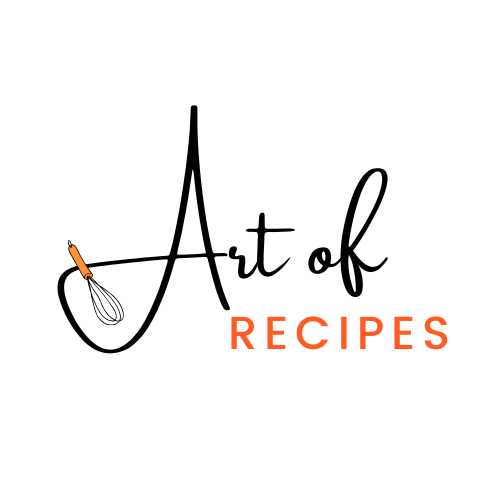Dutch ovens. If you don’t have one in your kitchen yet, trust me, you’re missing out! This versatile cooking tool is the unsung hero of hearty meals, flavorful soups, and even crusty artisan bread. In this guide, I’m going to walk you through everything you need to know about Dutch oven recipes—from what makes these pots so special to tips for making the most of them in your cooking adventures. By the end, you’ll be ready to whip up some amazing meals that’ll have everyone asking for seconds (or thirds!).
What is a Dutch Oven?
Okay, let’s start with the basics. What exactly is a Dutch oven? Think of it as the multitool of cookware—a heavy, lidded pot made from either cast iron or enameled cast iron. They’re built to last a lifetime and are perfect for everything from stovetop searing to oven baking.
The History of Dutch Ovens
The Dutch oven has quite the backstory. It dates back to the 17th century, when the Dutch developed a unique method for casting iron cookware. Fast-forward a few centuries, and it’s become a kitchen staple, prized for its durability and ability to cook food evenly. Imagine the same pot being passed down through generations—pretty cool, right?
Key Features and Benefits of Dutch Ovens
So, why all the fuss about Dutch ovens? Let me break it down:
- Heat Retention: Thanks to their thick walls, Dutch ovens retain heat like a pro. This means evenly cooked meals without those annoying cold spots.
- Versatility: From soups to stews, casseroles to baked bread, these pots do it all. You can even use them for frying or making desserts!
- Durability: A well-cared-for cast iron Dutch oven can literally last forever. Plus, they look gorgeous on your countertop.
- Health Benefits: Many people love cast iron for its ability to add a small amount of dietary iron to your meals. Who knew cookware could be good for you?
If you’re thinking of investing in one, just know it’s more than just a pot—it’s a game-changer for your kitchen.
Why Cook with a Dutch Oven?
Now that we’ve covered the basics, let’s talk about why you should use a Dutch oven in the first place.
Retaining Heat and Enhancing Flavor
Picture this: You’re cooking a pot of chili, and all those flavors have time to mingle and intensify because of the even heat distribution in a Dutch oven. It’s like a flavor party in your pot! Whether you’re slow-cooking beef or simmering a stew, the results are rich, tender, and oh-so-delicious.
Versatility: From Soups to Desserts
If there’s one thing that sets Dutch ovens apart, it’s how versatile they are. Need to bake a loaf of bread with the perfect crust? Done. Want to fry chicken or make a cobbler? No problem. It’s the ultimate one-pot wonder.
Essential Tips for Using a Dutch Oven
Using a Dutch oven is pretty straightforward, but a few pro tips can take your meals from “meh” to mouthwatering. Let’s dig into the essentials you need to know before you get cooking.
Seasoning and Caring for Your Dutch Oven
If you have a bare cast iron Dutch oven (as opposed to an enameled one), seasoning is the secret sauce to keeping it in tip-top shape. Don’t worry—it’s not as complicated as it sounds. Here’s the deal:
- Seasoning: This is just a fancy way of saying you’re creating a natural, non-stick surface by coating the pot with oil and heating it. After every use, wash your Dutch oven with warm water (no soap!) and a soft sponge, then dry it thoroughly and rub it with a thin layer of oil.
- Enameled Dutch Ovens: These are a bit less fussy since they don’t require seasoning. Just avoid using metal utensils or anything that could scratch the surface, and you’re good to go!
A little care goes a long way, and your Dutch oven will reward you with decades of dependable use.
Avoiding Common Mistakes
Even the best cooks slip up sometimes. Here are a few mistakes to steer clear of when using your Dutch oven:
- Using Too Much Heat: Dutch ovens retain heat exceptionally well, so cooking on high heat can cause scorching. Medium or low heat is usually plenty.
- Cooking Acidic Foods for Too Long: While you can totally make tomato-based dishes, prolonged cooking might affect the seasoning of cast iron. For enameled pots, though, you’re in the clear.
- Skipping Preheating: Preheat your Dutch oven before adding ingredients to ensure even cooking, especially for searing meat.
- Storing It While Wet: Always make sure your Dutch oven is completely dry before storing it. Trust me—nobody wants to deal with rust.
Avoid these pitfalls, and you’ll be cooking like a pro in no time.
Top Dutch Oven Recipes for Beginners
Ready to roll up your sleeves and get cooking? If you’re new to Dutch ovens, don’t worry—I’ve got some easy-peasy recipes that’ll make you feel like a culinary wizard.
Classic Beef Stew
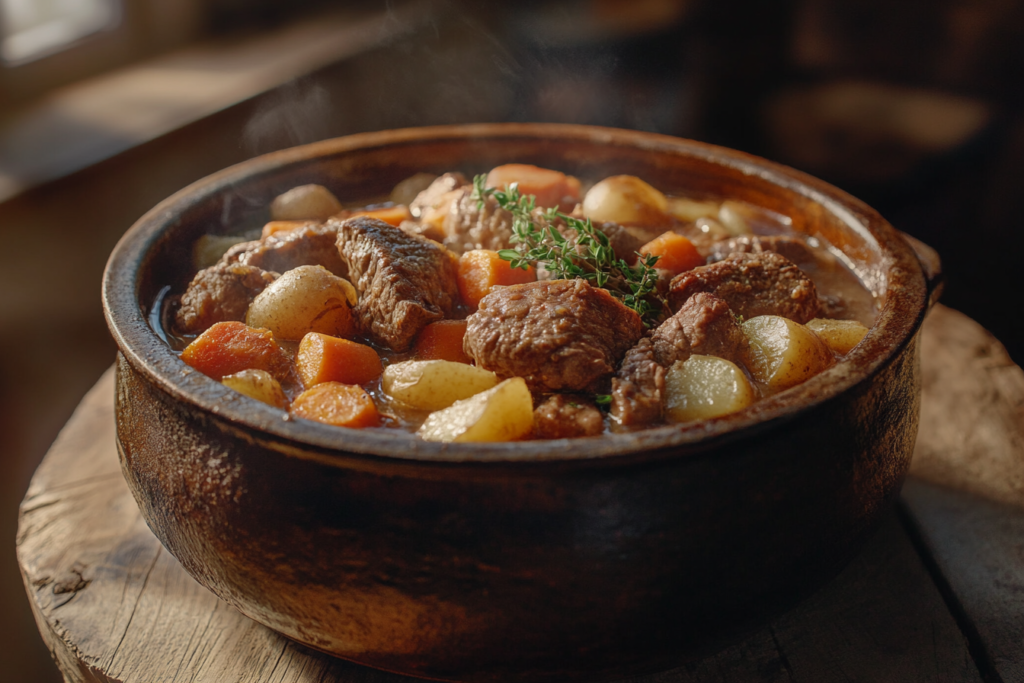
Is there anything cozier than a bowl of beef stew on a chilly day? With a Dutch oven, you’ll nail the tender meat and rich, hearty broth every time. Toss in some veggies like carrots and potatoes, and you’ve got yourself a meal that warms the soul.
Hearty Chicken Noodle Soup
This isn’t your average canned soup—it’s homemade, full of flavor, and ridiculously satisfying. The Dutch oven lets the flavors meld together beautifully, giving you that just-like-mom-made-it taste.
No-Knead Artisan Bread
Yes, you can bake bread in a Dutch oven, and yes, it’s easier than you think! This recipe is perfect for beginners because there’s no kneading involved. You’ll end up with a golden, crusty loaf that tastes like it came straight from a bakery.
Handy Table for Classic Beef Stew
| Nutrition Facts (per serving) | Ingredients | Quantities |
|---|---|---|
| Calories: 350 kcal | Beef chunks | 1 lb (450 g) |
| Protein: 30 g | Potatoes, diced | 2 large |
| Fat: 12 g | Carrots, chopped | 3 medium |
| Carbs: 25 g | Onion, diced | 1 medium |
| Prep Time: 20 min | Garlic cloves, minced | 3 cloves |
| Cooking Time: 2 hours | Beef broth | 4 cups |
| Total Time: 2 hours 20 min | Tomato paste | 2 tbsp |
Advanced Dutch Oven Recipes for Enthusiasts
If you’ve mastered the beginner recipes and feel ready to take things up a notch, Dutch ovens have your back. These recipes are a little fancier, but trust me, they’re totally worth the effort. Let’s explore some showstoppers that’ll impress your family and guests alike.
Coq au Vin
This French classic sounds fancy (and okay, it kinda is), but it’s also surprisingly doable in a Dutch oven. Picture tender chicken braised in a rich red wine sauce, flavored with garlic, mushrooms, and herbs. The Dutch oven works its magic here, infusing the chicken with bold, savory flavors. Serve it with crusty bread or mashed potatoes, and you’ve got a dinner that feels like a hug on a plate.
Braised Short Ribs
Short ribs are the epitome of comfort food. Braising them in a Dutch oven turns them into melt-in-your-mouth goodness. You’ll need patience for this one—it’s a slow-cooked recipe—but the payoff is meat so tender it practically falls off the bone. Add some red wine, beef stock, and aromatic herbs, and you’ve got a dish that’ll make you look like a gourmet chef.
Moroccan Lamb Tagine
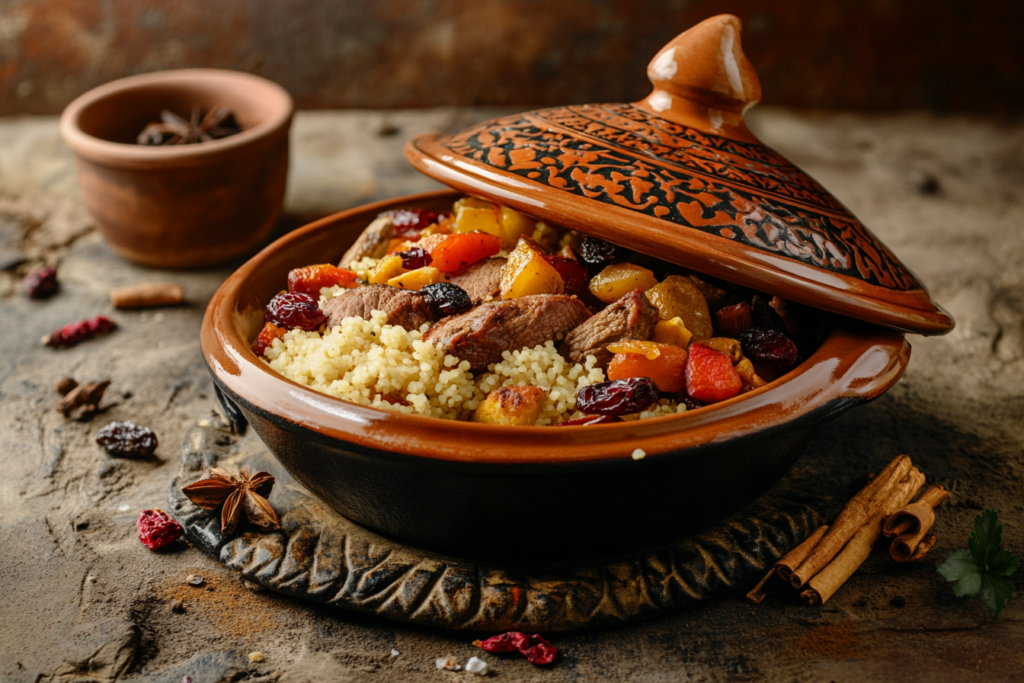
Here’s one for the adventurous cooks out there. A lamb tagine is bursting with warm spices like cinnamon, cumin, and turmeric, combined with sweet notes of dried apricots or raisins. While traditional tagines are made in a cone-shaped clay pot, a Dutch oven is a fantastic alternative. Pair it with fluffy couscous, and you’ll feel like you’ve traveled to Morocco without leaving your kitchen.
Vegetarian and Vegan Dutch Oven Recipes
Dutch ovens aren’t just for meat lovers. They’re amazing for creating plant-based dishes that are hearty, flavorful, and satisfying. Whether you’re a vegetarian or just looking to mix up your meals, these recipes are winners.
Lentil and Vegetable Stew
This stew is proof that comfort food doesn’t need meat. Lentils, loaded with protein and fiber, take center stage here. Toss in some carrots, celery, potatoes, and a mix of spices like paprika and thyme, and let the Dutch oven do its thing. The result? A rich, filling stew that’ll have you coming back for seconds (and maybe thirds).
Vegan Mushroom Risotto
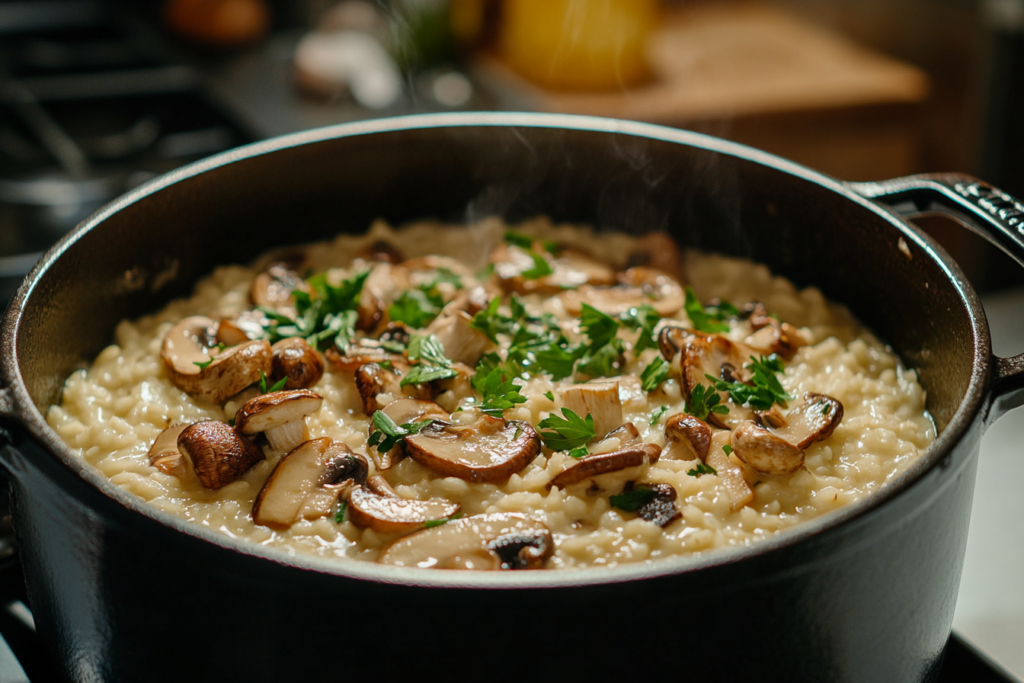
Risotto in a Dutch oven? Absolutely! This creamy, dreamy dish swaps the dairy for plant-based alternatives without losing any of that luxurious texture. The Dutch oven ensures even cooking, so your rice comes out perfectly tender. Add a medley of mushrooms for an earthy, umami-packed flavor, and garnish with fresh parsley or a drizzle of olive oil.
One-Pot Meals: Simplify Cooking with Dutch Oven Recipes
Here’s the beauty of a Dutch oven—it’s the ultimate tool for one-pot meals. Less mess, less stress, and all the flavor. These dishes are perfect for busy weeknights when you want something hearty and delicious without the pile of dirty dishes afterward.
Jambalaya
Spicy, smoky, and oh-so-satisfying, jambalaya is a Southern classic that shines in a Dutch oven. It’s loaded with rice, sausage, shrimp, and a mix of Cajun spices that’ll have your taste buds dancing. Plus, it’s super customizable—add chicken, swap the shrimp, or adjust the spice level to make it your own.
Chicken and Rice Casserole
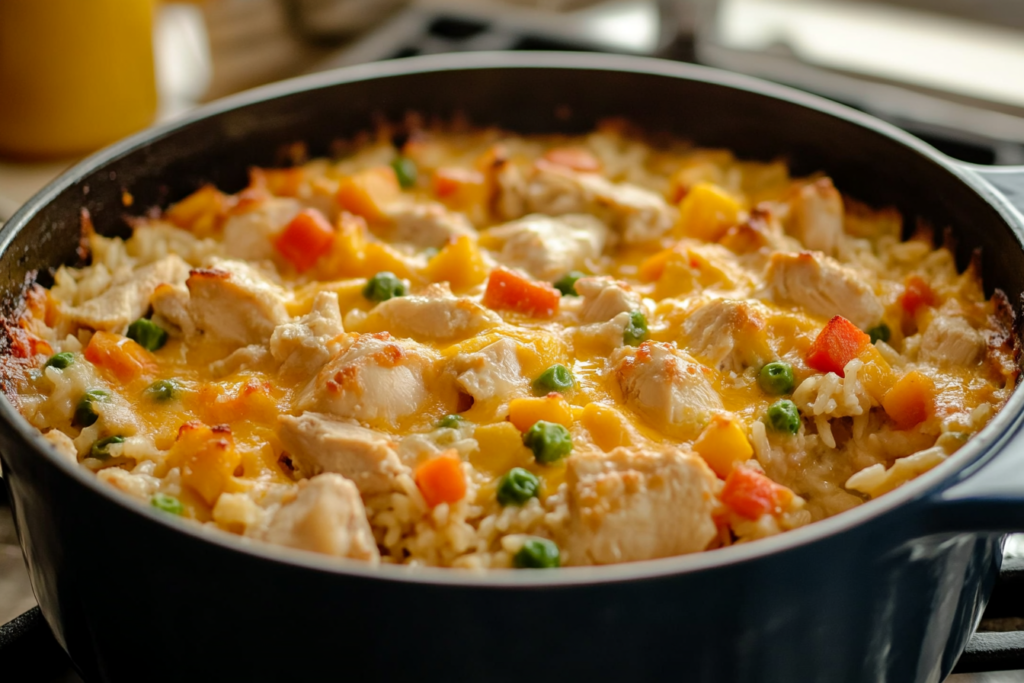
This dish is as simple as it gets, but don’t let that fool you—it’s packed with flavor. The Dutch oven creates the perfect environment for cooking the chicken until it’s juicy and tender, while the rice absorbs all those savory juices. Add some veggies and a sprinkle of cheese on top, and you’ve got a comforting meal the whole family will love.
Tips for Baking in a Dutch Oven
Did you know your Dutch oven doubles as a mini oven? Yep, it’s perfect for baking! Whether you’re making bread, cobblers, or even cakes, here’s how to get the best results.
Achieving the Perfect Crust in Breads
Baking bread in a Dutch oven is practically foolproof. The thick walls and tight-fitting lid trap steam, which creates that crispy, golden crust bakers dream of. Preheating the pot before adding your dough is key—think of it as giving your bread a warm hug to help it rise and bake evenly.
Dutch Oven Desserts: Cakes, Cobblers, and More
Why stop at bread? Your Dutch oven is also a dessert powerhouse. From gooey chocolate lava cakes to fruity cobblers topped with golden biscuits, the possibilities are endless. One pro tip: use parchment paper to line the pot for easy cleanup and flawless presentation.
Choosing the Best Dutch Oven for Your Kitchen
If you’re ready to jump into the world of Dutch oven cooking, picking the right one can feel a bit overwhelming. But don’t worry—I’ve got you covered with some straightforward advice to help you choose the perfect pot.
Materials: Cast Iron vs. Enameled Cast Iron
First things first: What’s the difference between plain cast iron and enameled cast iron? And which one should you choose?
- Cast Iron: Traditional cast iron is super durable and gets better with age (like a fine wine). You’ll need to season it and take care to avoid rust, but it’s unbeatable for heat retention. Plus, it’s budget-friendly.
- Enameled Cast Iron: These are the fancier cousins of traditional cast iron. They come with a smooth, colorful coating that doesn’t need seasoning and is easy to clean. The downside? They’re a bit pricier, but totally worth it for their convenience and style.
If you want versatility and don’t mind a little maintenance, go for plain cast iron. If you’re all about low-maintenance cookware that looks Instagram-ready, enameled is the way to go.
Sizing Guide: Which Dutch Oven is Right for You?
Size matters—at least when it comes to Dutch ovens! Here’s a quick guide:
- Small (2-3 quarts): Great for side dishes, sauces, or cooking for one.
- Medium (5-6 quarts): The sweet spot for most households. Perfect for soups, stews, or casseroles for 3-4 people.
- Large (7+ quarts): Best for big families, meal prep, or entertaining. You’ll have plenty of room for larger cuts of meat or big batches of chili.
If you’re unsure, go with a medium size. It’s the most versatile and works for almost any recipe.
Common Questions About Dutch Oven Recipes
Let’s tackle some of the most common questions people have about Dutch ovens. You might be wondering about these too!
Can You Use a Dutch Oven on All Cooking Surfaces?
The short answer? Yes! Dutch ovens are incredibly versatile. They work on gas, electric, induction, and even over an open flame or campfire. Just make sure to check the manufacturer’s guidelines if you’re using an induction cooktop.
How to Prevent Food from Sticking in a Dutch Oven?
Sticking happens to the best of us, but there are ways to avoid it:
- Preheat your Dutch oven before adding oil or ingredients.
- Use enough oil or butter to create a barrier.
- Avoid cooking on high heat unless you’re searing something quickly.
- For sticky foods like bread dough, use parchment paper as a liner.
A little care goes a long way in keeping your Dutch oven stick-free!
When exploring the world of Dutch oven recipes, you’ll discover the versatility and depth of flavors these cooking vessels offer. For those new to this culinary tool, learning about the basics of seasoning and caring for your Dutch oven is essential. To enhance your cooking repertoire, try starting with simple yet flavorful meals such as this Juicy Smoked Turkey, or experiment with hearty dishes like a smoked turkey wings recipe. If you’re feeling adventurous, consider pairing your Dutch oven meals with Mediterranean-inspired sides like how to cook and eat branzino, for a complete and satisfying dinner experience. Each of these recipes offers unique insights and tips to elevate your Dutch oven cooking to new heights.
FAQs
To finish things off, here’s a quick FAQ section to clear up any lingering doubts.
What’s good to cook in a Dutch oven?
Dutch ovens are perfect for soups, stews, braised meats, casseroles, artisan bread, and even desserts like cobblers. They’re your go-to for any dish that benefits from slow cooking or even heat distribution.
Is there anything you shouldn’t cook in a Dutch oven?
Avoid delicate foods like fish that need quick cooking, as they can overcook easily. Also, don’t cook acidic dishes like tomato-based sauces for too long in bare cast iron—it can strip the seasoning.
What are 8 reasons to use a Dutch oven?
Dutch ovens are versatile, retain heat well, are durable, perfect for one-pot meals, work on any heat source, bake bread with crispy crusts, transition from stovetop to oven seamlessly, and elevate flavor in slow-cooked dishes.
What is the best meat to cook in a Dutch oven?
Tough cuts like beef chuck, short ribs, lamb shanks, and pork shoulder shine in a Dutch oven. The slow cooking breaks down the fibers, making the meat tender and flavorful.
And there you have it—everything you need to know to master Dutch oven recipes and make the most of this kitchen workhorse. Whether you’re a beginner or an experienced cook, there’s something magical about the meals you can create with a Dutch oven. Now go grab yours, and let’s get cooking!
